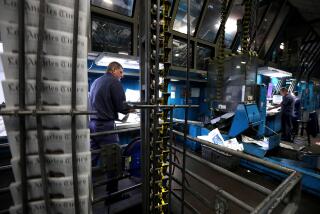International Business : Factory Closure in ‘Nissan Town’ Marks an End to Postwar Miracle : Autos: Big export companies are in a double bind these days: dampened demand from recession and the profit-cutting strength of the yen.
- Share via
ZAMA, Japan — For more than three decades, this city was known as “Nissan Town.” Its sprawling auto assembly plant was a point of pride, a symbol of Japan’s postwar economic miracle.
But at the end of this month, Nissan Motor Co., Japan’s second-largest auto maker, will close the core section of its facility here--the first such shutdown by a Japanese auto maker since World War II.
In many ways, the closing epitomizes the woes of the Japanese economy, which is struggling to pull out of its worst slump since the war.
Big export companies such as Nissan--the powerful engines that drive the world’s second-largest economy--are in a double bind these days.
At home, the recession has dampened demand, sending domestic profits spiraling downward. And overseas, the strength of the yen makes Japanese products ever more expensive, cutting deeply into earnings.
This week, the yen has soared to new heights against the U.S. dollar, reaching its highest levels since the modern exchange-rate system was established half a century ago. In the last three weeks alone, the Japanese currency has appreciated nearly 10% against the dollar. In New York trading Wednesday, the dollar closed at 91.33 yen.
In Zama, a city of 100,000 people 50 miles west of Tokyo, the pain is palpable. Nissan was once Zama’s lifeblood. In 1992, it accounted for nearly a fifth of the city’s tax base, said city official Yoshinori Kato. That has already fallen off sharply as operations have dried up.
Some Nissan branches at Zama will remain functioning: model designs, research, and machinery and auto parts production. But the assembly plant--the facility’s centerpiece, which has churned out 10 million cars since 1964--will be idled March 31.
The company says the Zama shutdown is part of a long-term modernization strategy that will ultimately strengthen Nissan.
But the ripples are already spreading beyond the 2,000 auto workers affected. Toshimasa Magaki owns a two-story, 10-room inn near a railroad station. His earnings have been cut in half since Nissan announced its closure plans two years ago.
“This is the worst slump in my business in the past three decades,” he said. Once the shutdown goes through, he said, he may have to close his hotel.
Mikio Sekiguchi, a taxi driver, said he and his colleagues are already seeing a 10% to 15% drop-off in monthly income and expect it to get worse.
On a recent afternoon, the plaza outside the assembly plant was all but deserted. Guards in blue uniforms kept reporters away, saying the company had declared the area off-limits. Most workers walking out of the gate were tight-lipped.
Nissan officials said that as of the end of February, nearly 1,000 Zama workers had been transferred to various other Nissan facilities.
Before the nation’s economy began slowing five years ago, Japan’s auto makers plowed profits back into capital investments. But with demand declining and costs climbing, the companies are now under heavy repayment burdens.
Nissan has already embarked on a dramatic cost-cutting drive, and on Monday it said it would aggressively continue that program over the next three years.
More to Read
Inside the business of entertainment
The Wide Shot brings you news, analysis and insights on everything from streaming wars to production — and what it all means for the future.
You may occasionally receive promotional content from the Los Angeles Times.










